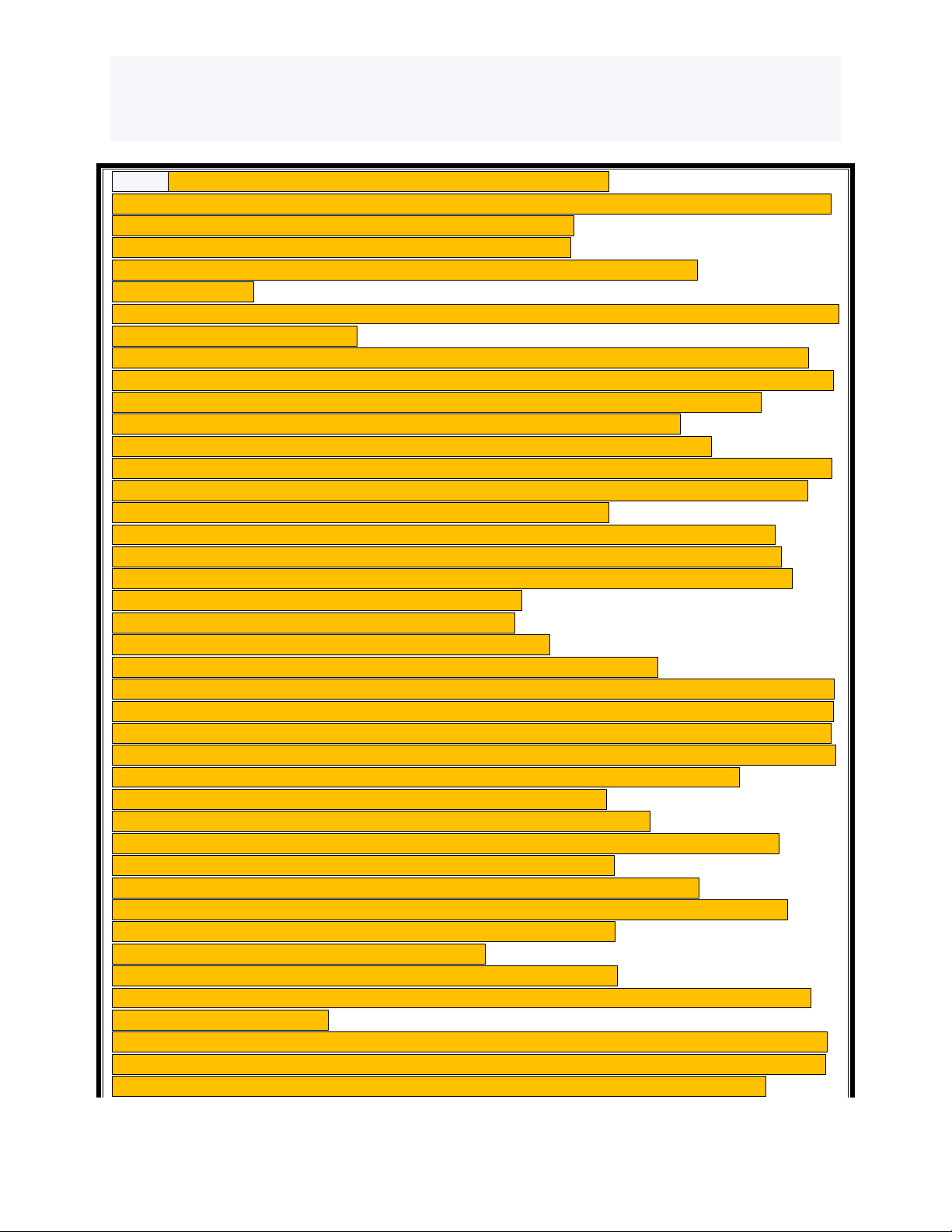
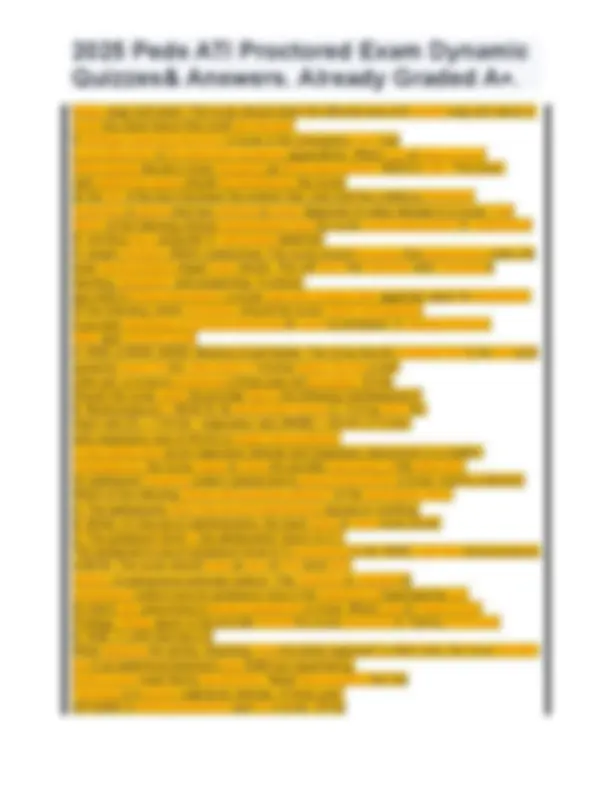
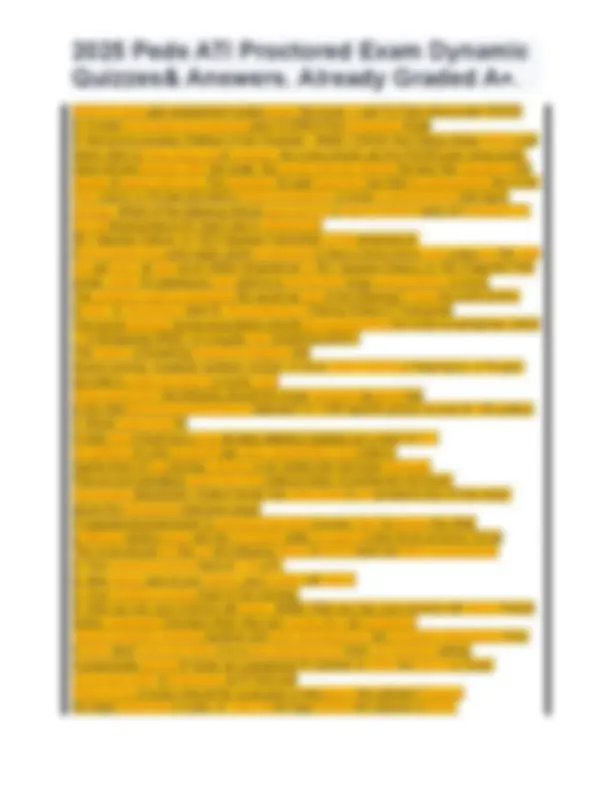
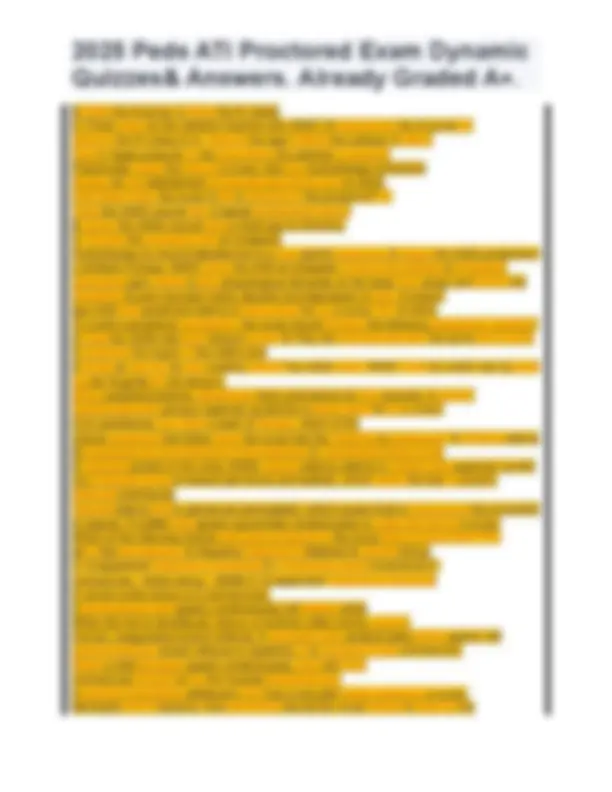
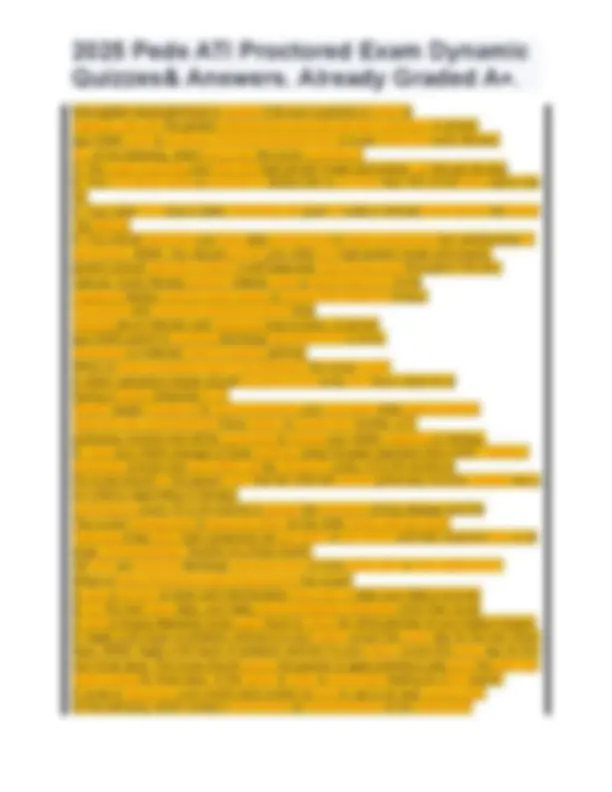
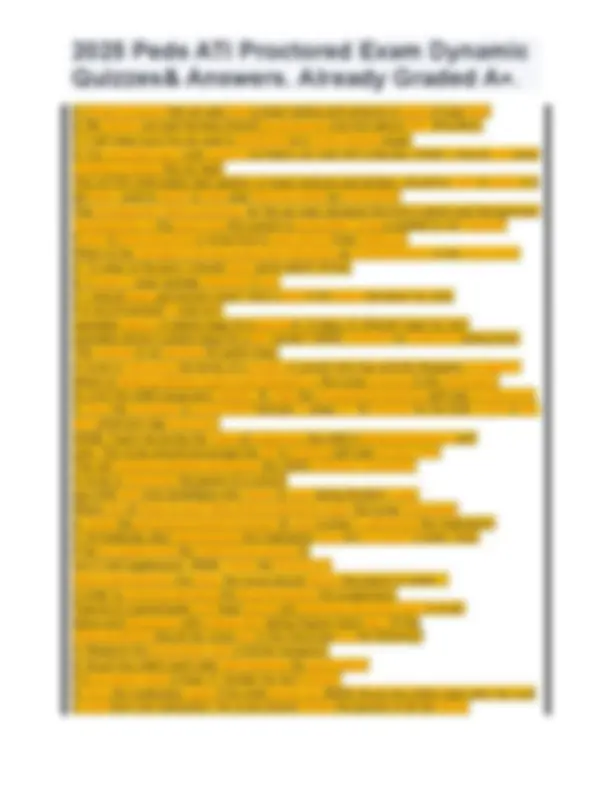
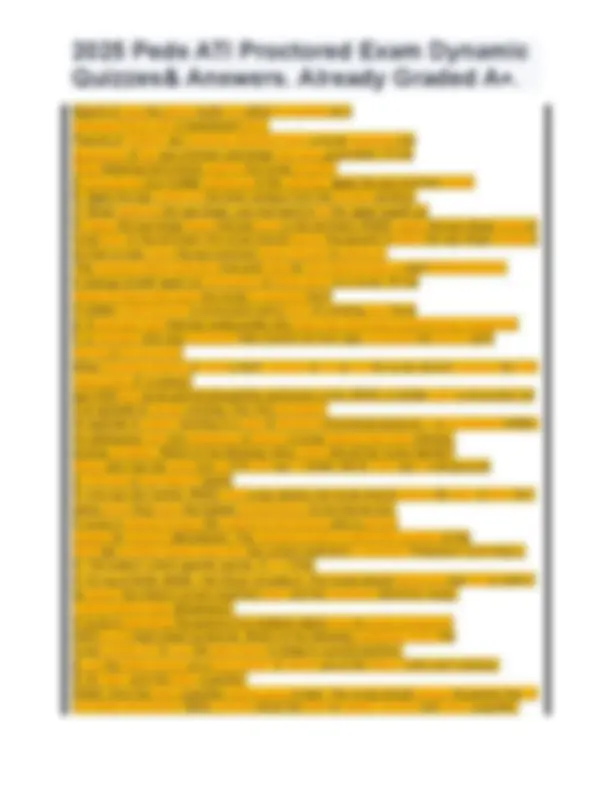
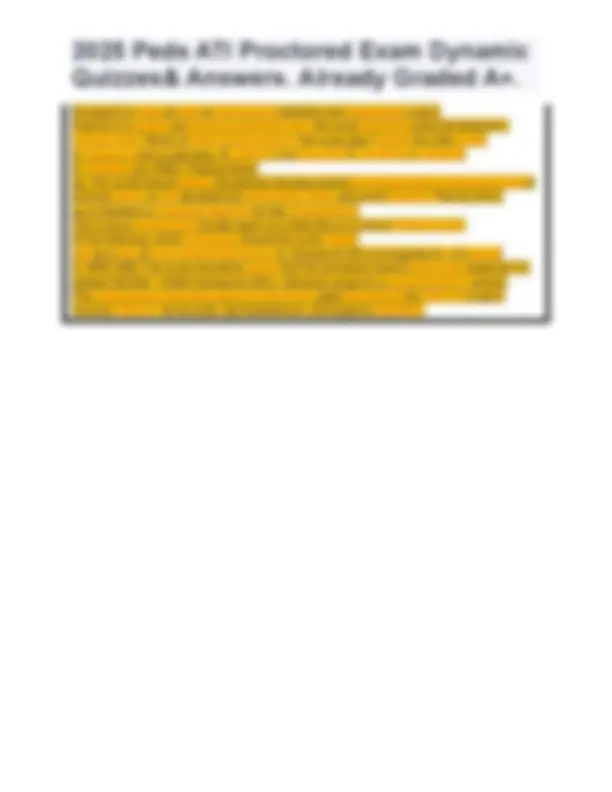


Study with the several resources on Docsity

Earn points by helping other students or get them with a premium plan


Prepare for your exams
Study with the several resources on Docsity

Earn points to download
Earn points by helping other students or get them with a premium plan
Community
Ask the community for help and clear up your study doubts
Discover the best universities in your country according to Docsity users
Free resources
Download our free guides on studying techniques, anxiety management strategies, and thesis advice from Docsity tutors
348 Exam 1 Questions With Correct Detailed Answers..
Typology: Exams
1 / 13

This page cannot be seen from the preview
Don't miss anything!








Preparing an in-service for a charge nurse at an emergency room A cohort of recently certified nurses discussing the clinical presentations of infant Mistreatment. Which clinical symptom from the list below should the charge Did the nurse mention any signs of possible physical abuse? A- Chronic infections of the urinary tract B) Symmetric Lower Extremity Burns C: Inability to grow D: Absence of subcutaneous fat; ANSB: Symmetric burns of the lower extremities; The nurse sh ould cover this in the instruction. The clinical indication of physical abuse that is suggestive is the extremities. The tendencies typically reflect the style or tool being used, like a cigarette or cigar. burns or burns with an iron- like form. A nurse is evaluating a teenage patient at an urgent care facility who has an upper respiratory infection. Which of the following conclusions ought to the acknowledged by a nurse as a sign of pertussis? A sore throat discharged from B) purulent tear discharge in the eyes C: Prickly, dry cough A dry, hacking cough is a sign of D- koplik spots on the buccal mucosa and ANSC, which the nurse should be aware of. pertuss. Typically, this illness starts with symptoms of an upper respiratory tract infection, which can result in a dry, hacking cough that is occasionally more severe harsh in the evening. In a physician's office, a nurse tends to a school-age child who has Varicella. When will the parent's child no longer be in the care of the nurse? comunicative. Which answer choice is the nurse supposed to make? A: After the fever of your child has returned to normal B: Three days after you initially observed your child's rash C: Six days after your child's lesions first show, when they have crusted. A nurse should notify the parent that their kid is contagious one day before the lesion eruption a nd until the vesicles have crusted over, which normally takes around two to three weeks. D: Wh en your child's lesions entirely disappear; ANSC: When your child's lesions are crusted, six day s after they occur. Six days. In the provider's office, a nurse gets ready to provide a vaccine to a child in the midst of a well-child visit. Which of these steps ought to be taken by the What is the nurse's plan of action? Medication recommendations:
strong egg or gluten sensitivity should not have this vaccination. A three-month- old baby is being evaluated by a nurse in an emergency room. Someone is suffering from extreme vomiting and diarrhea due to rotavirus. Out of which The following symptoms should be recognized by the nurse as signs that Is there moderate to severe dehydration in the infant? Heart rate: 124 beats per minute B) Produce more tears C: Submerged front fontanel D: 2 seconds for capillary refill; ANSC: sunken anterior fontanel; The nurse should be aware tha t a sunken anterior fontanel is a sign of due to the sudden loss of fluid, moderate to severe dehydration. A school- age youngster suffering from an allergic reaction is being attended to by a nurse at an emergen cy facility. Of the following, which one is the What is the nurse's top priority? A. Raise the child's bed head. B: Give the child a large-bore IV catheter. C) Identify which allergy triggered the child's reaction. D: Give the person instantaneous epinephrine ANSD: Give the infant intramuscular epinephrine (IM) child; The nurse decides that, while applying the urgent vs. no urgent approach to client care, Giving the youngster intramuscular (IM) epinephrine is the first step. Amid an bronchoconstriction brought on by histamine release, anaphylactic response, and dilation of the vaso. Since it finally results in lowered blood pressure, this is an emergency. retrace your steps to the heart. A physical assessment is being conducted by a nurse in the emergency department. on a boy baby who is two weeks old. Which of the above examples best describes the is it the nurse's top priority to inform the provider? A: The excoriated scrotal region B: Hemangiomas in numerous capillaries C- posterior fontanel depressed D- substernal retractions - ANSD- substernal retractions; When providing client care utilizing the airway, breathing, and circulation method, the nurse should decide that substernal is the top finding to report to the provider. retreats. According to this discovery, the child is having acute respiratory distress and heightened struggle in breathing, which could rapidly escalate to respiratory malfunction. A school- age youngster receiving care from a nurse in the emergency room has epiglottitis. Which of the following steps ought to be carried out by the nurse? A: Take a throat culture from the young person. B) Track the child's saturation of oxygen C: Equip the child's room with a warm mist humidifier. D: Lay the child down on his or her back; ANSB: Check the child's oxygen saturation; The nurse needs to check the child's oxygen saturation since the youngster is having severe breathing difficulties, and it is important to ascertain whether the youngster is reacting to the medical intervention. A toddler with partial cerebral palsy is being cared for by an emergency room nurse. His right arm is burned with thickness. Which of these steps ought to be taken by the take a nurse? A. Nasogastric tube insertion B. Start taking antibiotics as preventive measure C) Wash the impacted area with a gentle soap solution. D: Treat the affected region with a topical corticosteroid; ANSC: Wash the affected area with mo
Which of these pain assessment scales ought the nurse to use? A: Pain rating scale FACES B: A scale of numbers for assessing pain C-CRIES Pain Evaluation Scale D: Noncommunicating Children's Pain Checklist - ANSA: FACES Pain Rating Scale; When a pe diatric client is three years old or younger, the nurse should use the FACES pain rating scale. years old and beyond. With this scale, the young child can identify the face that represents the degree of agony right now. The necessity for pain treatment can then be assessed by the nurse. After a burn, a 10 - year-old child is being evaluated by a nurse to determine his vital signs. damage. Which of the following clinical signs point to a sepsis infection early on? Surprise? A- 90/130 blood pressure B: Heart rate in milliseconds 39.1 degrees Celsius, or 102 .4 degrees Fahrenheit, is the temperature. A kid experiencing early septic shock is expected to have a fever and a urine output of 100 millili ters per hour, as well as an ANSC temperature of 39.1 degrees Celsius, or 102.4 degrees Fahr enheit. colds. An adolescent with asthma is having their lungs auscultated by a nurse. The caregiver ought to recognize the sound as one of the following? Press the audio button. to hear. A. Respiratory biots B. The breathing of Chaney Stokes C-Tachypnea The sound detected during auscultation should be recognized by the nurse as tachypnea, which is D-Bradypnea-ANSC. is a regular, fast breathing pattern. This rhythm of breathing frequently happens with Severe anemia, metabolic acidosis, anxiety, or fever. After suffering a head injury, a 10 - year- old child is under the care of a nurse. That What results from the following should the nurse recognize as proof that Is the child becoming inactive due to diabetes? A: 1.045 specific gravity of urine B- 155 sodium C: Blood sugar level 45 A child with a head injury may develop diabetes insipidus as a result of D— 35 milliliters of urine produced per hour—and ANSB— 155 sodium. hypofunction of the pituitary resulting in an antidiuretic hormone shortage. Polyuria and polydipsia result from the underexcretion of antidiuretic hormone. conceivably dehydration. Sodium levels rise when there is an excessive loss of free water. above the anticipated reference range. A hospitalized preschooler is receiving care from a nurse. Mom is leaving the child. a different relative stays with the youngster while you spend a few hours at home. Of the The nurse should tell the kid the following things to clarify when her Mom coming back? A: Your mother is coming back at 7:00 p.m. B: After taking care of your sibling, your mother will return. C: Your mother is coming back in the morning. D: After you eat, your mommy will return. ANSD: After you eat, your mommy will return. Presch oolers understand time best when they can connect it to an anticipated regular schedule, including bedtime and food. Consequently, the youngster understands time. It works best if you can relate it to a past experience for them. for instance, eating. A preschooler getting IV fluids via a peripheral IV catheter is under the care of a nurse. As you get ready to stop giving an IV fluid and What course of action should the nurse plan to take about the catheter? Position the steps performed in order. A. Take off the tape holding the catheter in place.
B. Stop the IV pump. C: Stop the IV tubing D. Press down on the catheter insertion site (ANS1) B. Disconnect the IV pump C- obstruct the IV tubing 3) A. Take off the tape holding the catheter in place. Step 4: Apply pressure to the area where the catheter is inserted. Preschooler under the care of a nurse, who has hydrotherapy scheduled therapy for the debridement of wounds after burns. Out of which what steps ought the nurse to do in advance of the procedure? A- Treat the child's wound with a topical antibacterial cream. B: Cover the child's wound with a mesh gauze dressing. C: Provide the youngster with an analgesic Hydrotherapy for wound debridement is a very painful treatment. D: Begin the child's prophylacti c antibiotic therapy. ANSC: Give the child an analgesic. It has to be sedated or analgesic. Controlling pain results in less physiological demands on the body from stress and lowers the possibility of post-traumatic stress disorder and depression in kids. A school- age child with peripheral edema is being cared for by a nurse. Out of which To confirm peripheral neuropathy, the nurse should conduct the following evaluations. swelling? A: Feel the child's feet from dorsum to toe. B. Play the kid every day with the same set of rules. C: Examine the turgor of the child's skin D: Keep an eye out for any swelling around the child's eyes; ANSA: Feel the child's feet by push ing her fingertip on the dorsum. detect peripheral edema, observe the bony prominence for five seconds. A school- aged student with primary nephrotic syndrome is being cared for by a nurse. is on prednisone, too. After a week of therapy, which of the clinical symptoms that follow show the nurse that the medicine is productive? A) Reduce edema B) expanding the circumference of the abdomen C- Diminished desire to eat D: elevated protein in the urine; ANSA: reduce edema; edema in children with nephrotic syndro me is brought on by increased glomerular permeability, which raises the loss of protein. Reduced prednisone reduced edema due to glomerular permeability, which causes fluid to move out of the extracellul ar spaces. A toddler with spastic (pyramidal) cerebral palsy is under the care of a nurse. Which of the following clinical signs and symptoms is the nurse likely to encounter? Pick all of that are relevant. A) Negative response to Babinski B: Clonal clonus C: Exaggerated response to stretching D – involuntary facial movements E- contractures - Ankle clonus - ANSB C: Exaggerated response to stretching A correct ankle clonus is E-contractures. A young person with spastic cerebral palsy will display ankle When the foot is dorsiflexed, clonus, a rhythmic reflex tremor, occurs. Correct, exaggerated stretch reflexes. A youngster with cerebral palsy that is spastic will evince excessive stretch reflexes or spasticity. It is accurate to say contractures. When a child develops spastic cerebral palsy, they will show contractures brought on by the muscles becoming taut. A recently hospitalized adolescent with has a care plan being created by a nurse. Meningitis due to bacteria. How much time should the nurse budget to keep up the
C: Before exposing kids to the sun, cover them with loose-woven polyester clothing. A waterproof sunscreen with an SPF of at least 15 should be chosen; the nurse should advise p arents to use a waterproof sunscreen with at least 15 SPF. D. Reapply sunscreen every 4 hours
. 15 at least for kids. Prior to being in the sun, parents should apply sunscreen. to lessen the chance of being burned in the sun. Children at a community health center are having their hearing examined by a nurse. Okay. To which of the following kids should the nurse make a referral? a more comprehensive assessment of hearing? A 18 - month- old infant whose speech is incomprehensible B: A three-month- old newborn exhibiting an atypical startle response C is a 4 - year- old preschooler who enjoys playing with other kids more than playing by themselves. An infant who is eight months old and not yet making babbling noises is classified as D or ANS D. The nurse should make a referral for a child who is not yet making babbling sounds by the ag e of seven. months to a provider for an in-depth assessment of hearing. A toddler with a serum lead level of 4 mcg/dL is being planned for care by a nurse. Which of the following steps ought the nurse to arrange to undertake? A: Advise parents to cut back on calcium intake for their toddler. B) Get the child ready for chelation therapy. C: Contact Child Protective Services on behalf of the family D: Arrange for the toddler to have an annual screening; ANSD: Arrange for the toddler to have a n annual screening; The nurse should arrange for the toddler to have a lead level rescreening in one year and Teach the family protective measures to avoid exposure. For a 10 - year- old who was just admitted, a nurse is organizing developmental activities. youngster suffering from neutropenia. What course of action ought the nurse to take? intend to do? A book on adventures should be given to the child. B. Set up regular visits from peers and relatives C: Provide a large-piece puzzle to the child. D. Use a puppet to amuse the child; ANSA. Give the child a book about adventure; A nurse sho uld give a school-age child an adventure book as a developmental activity as children's knowledge base grows and creative thinking at this age. A teenager is getting ready for a lumbar puncture by a nurse. Of the Which of the following steps ought the nurse to take? A- Before the procedure, put the teenager on a heart monitor. B: An hour before the surgery, treat the area with topical analgesic lotion. C: Maintain the adolescent in a modified Fowler's posture for four hours after the protocol The nurse should apply a topical analgesic cream to the site one hour prior to the operation; D i s to restrict fluids for two hours after the procedure. The lumbar site should receive this treatme nt 60 minutes beforehand. Method to lessen the teenager's discomfort during the lumbar puncture. Preparing to take a toddler's sample for a sickle turbidity test, a nurse trial. Which course of action ought the nurse to plan to follow? A. Gather a sample of sputum. B. Conduct an Allen test C: Stick your fingers together. The nurse should do a finger stick on a toddler as part of the sickleturbidity protocol. D: collect a stool specimen; ANSC: execute a finger stick. trial.
Hemoglobin electrophoresis is needed if the test is positive in order to separate kids with the genetic characteristic from kids that don't sickness. A school- age child's mom is receiving nutritional education from a nurse. bears the cystic fibrosis. Out of the following, which one ought the nurse to produce? A: You ought to provide your kids with high-protein meals and snacks. all through the day B. Your youngster needs to cut back on dietary fats to no more than 10% of her daily caloric inta ke. C: Your child must take a tablet containing one gram of sodium chloride every day for the rest of her lifelong D: You should determine your kid's daily activity level in order to determine her carbohydrate re quirements. ANSA: You should provide your child with high-protein meals and snacks. parents should feed their children a well-balanced, high-protein food throughout the day. calories. Cystic fibrosis patients' children need a larger proportion of the suggested dietary limits for each vitamin to ensure that needs for energy. Youngsters who consume wholesome foods have reduced risk of infection and enhanced lung function. A school- age child's parent is receiving discharge education from a nurse. possesses a moderate case of ongoing asthma. Which of these guidelines ought to be followed? the nurse entail? A child's salmeterol inhaler should be given to him every four hours when he is having a severe wheezing fit. B- Weekly weight monitoring is recommended for your youngster while getting inhaling treatment with corticosteroids Every twelve to twenty-four months, a C- pulmonary function test will be conducted to Assess your child's response to therapy. D. Take your child's average of three readings using the peak expiratory flow meter. readings- pulmonary function test and ANSC-will be carried out every 12 to 24 months to the nurse should let the parent know that her child will require pulmonary function; assess how y our child is responding to therapy. examinations every 12 to 24 months to assess the existence of lung disease and the The current therapy plan is having an effect on the child. When kids get older, There are times when their symptoms can get better or get worse, and their treatment has to ch ange. correspondingly. Parents of a three-month- old child are receiving discharge education from a nurse. baby after a knee replacement. Which of these directions ought to be given by the nurse? A: Use a solution of water and chlorhexidine every day to clean your baby's sutures. B: For the next three days, your baby should anticipate swallowing more than usual. C: Use a tongue depressor every eight hours to check for white patches on your baby's tongue. D: Apply a thin layer of antibiotic ointment to your baby's suture line every day for the next three days; ANSD: Apply a thin layer of antibiotic ointment to your baby's suture line every day for the next three days; The nurse should advise the parents to apply petroleum jelly after the baby has been treated for three days. to the region in order to encourage healing for a few weeks. A nurse is instructing a six-month-old's mother on how to use a car seat. young child. Of the following, which mother's words imply an comprehension of the instruction?
digoxin to stop the drug's tooth rot, which is supplied as a enhanced flavor with a sweetened drink. Parents of toddlers are receiving education from a nurse regarding the application of the eye ointment and drops that were prescribed. Of the What following instructions need to the nurse provide? A- As soon as your toddler wakes up in the morning, apply the eye ointment. dawn B. Apply the eye cream on the inner campus from the outside canthus. C: When applying the eye drops, use one hand to lift the upper eyelid up. D: Apply the eye drops three minutes prior to the ointment; ANSD: Apply the eye drops three mi nutes prior to the ointment; the nurse should advise the parents to apply the eye drops initially a nd then to wait. Give the eye ointment three minutes in advance. This measure offers sufficient time and gaps for the effectiveness of each individual drug. A change-of-shift report on youngsters is being given to a nurse. Of the Which of these kids ought the nurse to examine first? A toddler suffering from a concussion and a bout of vomiting with force B: A teenager with infective endocarditis who says they have been experiencing headaches C, a teenager who was just given Halo traction an hour ago, evaluates his level of pain scoring a six out of ten When deciding whether to treat a client urgently vs not at all, the nurse should evaluate the follo wing cases: D: a school- age child with acute glomerulonephritis and brown urine; ANSA: a toddler with a concussion an d an episode of strong vomiting. first, this youngster. An episode of violent vomiting is a sign of elevated intracranial pressure of a concussed toddler. An adolescent with iron deficiency is having a nurse assess their food choices. anemia of deficit. Which of the following menu items should the nurse identify? Which item has the most iron in it?A half cup of whole milk B: One cup of orange juice C: One and a half cups of raisins D: one cup raw carrots; ANSC: half a cup raisins; the nurse should advise the teen to take the r aisins since they have the highest concentration of non-heme iron. A nurse is looking through the newborn's test results who is getting therapy for extreme dehydration. The caregiver ought to determine whether of the What lab numbers below show that the current treatment is working? Potassium (2.9 mEq/L). B: 140 sodium urine's specific gravity, C, is 1.035. D: 25 mg of BUN; ANSB: 140 mEq/L of sodium; The nurse should determine that this is within t he shows the infant's current treatment plan and the projected reference range. It works well to treat dehydration. A nurse is educating the parents of a newborn about how to avoid unexpected SIDS is the infant death syndrome. Which of the following guidelines ought the nurse consist of? A: Lay the baby down to sleep in a prone position. B. Let the baby snooze on a big cushion. C: Make use of the baby's crib's soft mattress. D) At night, give the baby a pacifier. ANSD: Give the baby a pacifier before going to bed. The nurse should advise the parent that so me things can prevent SIDS, such as when the baby is asleep, nursing and using a pacifier.
A nurse should advise the parent to put the baby in a supine position. The parents of a school- age child with osteomyelitis of the tibia receiving a new diagnosis are being instructed by a nurs e. Which of the following parent remarks demonstrates a comprehension of the instruction, accordi ng to the nurse? A cast will be on my child till the healing process is over. B: For a few weeks, my child will take antibiotics. C: My kid can resume participating in sports after he is released. D: My kid needs to communicate solitude. The nurse ought to inform the parent that their child will be undergoing antibiotic therapy for a fe w weeks. ANSB: four weeks at least. If the antibiotics do not work, surgery might be necessary. A toddler with cognitive impairments is being taught by a nurse. deficiency regarding potty training. which of the following guidelines Is the nurse to be included in the instruction? A: Admonish the youngster when he has An incident involving a toilet B. When the youngster uses the toilet chair, give him a sticker. C: As you educate the child how to use the potty chair, play his favorite music. A youngster with a cognitive impairment learns by modeling behaviors. D: teach several phases of the skill at once. ANSB: give the child a sticker when he uses the toilet chair. To reinforce their behavior, parents ought to provide their child a treat for using the toilet chair. the intended continence-related behavior. While the youngster continues in this manner, the parents can reward progressively lessens and then awards prizes for completing the subsequent assignmen t, like using the potty chair while urinating. While a school- age child is sitting, a school nurse is taking his blood pressure. sitting in a chair. A tonic- clonic seizure begins in the young person. Of the What steps should the nurse take first, if any? A- Get rid of anything dangerous in the child's near vicinity. B) Take off the child's constricting clothes C) Help the youngster lie on their side on the floor. The child's biggest risks are aspiration, obstruction of the airway, and physical harm. D: Put the child in an oxygen mask. ANSC: Help the child lie on his or her side on the floor. damage sustained from toppling over the chair. The nurse should calm the young patient down to immediately lie on your side on the floor. The child's position allows for the the mouth's secretions to drain, avoiding aspiration, and preserving a open airway. A teenager presenting with multiple burns in school is being evaluated by a school nurse. different healing phases. What actions from the list below ought the nurse to take? recognize as raising the possibility of physical abuse? A: Shows hesitation to leave the house B- gives an in-depth account of how the burns happened. When assessing injuries, C- denies feeling uncomfortable. The nurse should suspect child abuse in the form of physical abuse if the patient: D- describes strong relationships with peers; ANSC-denies discomfort during injury assessment. Adolescents respond less strongly to painful stimuli or injuries. The 15 - year- old client is receiving care from the nurse after suffering a head injury. Out of which The following observations should be noted by the nurse as proof that the child is SIADH (syndrome of inappropriate antidiuretic hormone secretion) developing? A-sodium 148
the parent to keep an eye on their level of hydration and appropriate output. Parents of a patient are receiving education from the nurse regarding social development. younger child. Which of these games ought to the nurse play? advise the child to do? A: Engage in pat-a-cake play. B: utilizing a toy that pulls C: compiling a notebook D: Dressing up; ANSD: Playing dress- up; The nurse should advise the parents that play should be concentrated on learning during pr eschool years. on the development of the body, mind, and social aspects. Playing dress- up is therefore a suggested playtime for this young person. The nurse is looking over the lab report of a child who is in school. feeling weary. Of the following, which conclusion should the nurse make? see as a sign of low red blood cell count? A: Hematocrit 28% Hemoglobin B: 13.5 grams C- 8000 WBC The nurse should be aware that this hematocrit level is lower than expected (D- platelet 250,000 - ANSA-Hematocrit 28%). reference range for a young student in school. The young person may show signs of exhaustion, pallor because of the reduced oxygen- carrying capacity, tachycardia, lightheadedness, and dyspnea capability.